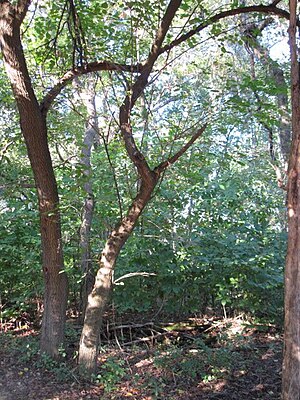
In agriculture, polyculture is the practice of growing more than one crop species together in the same place at the same time, in contrast to monoculture, which had become the dominant approach in developed countries by 1950. Traditional examples include the intercropping of the Three Sisters, namely maize, beans, and squashes, by indigenous peoples of Central and North America, the rice-fish systems of Asia, and the complex mixed cropping systems of Nigeria.
Polyculture offers multiple advantages, including increasing total yield, as multiple crops can be harvested from the same land, along with reduced risk of crop failure. Resources are used more efficiently, requiring less inputs of fertilizers and pesticides, as interplanted crops suppress weeds, and legumes can fix nitrogen. The increased diversity tends to reduce losses from pests and diseases. Polyculture can yield multiple harvests per year, and can improve the physical, chemical and structural properties of soil, for example as taproots create pores for water and air. Improved soil cover reduces soil drying and erosion. Further, increased diversity of crops can provide people with a healthier diet.
Disadvantages include the skill required to manage polycultures; it can be difficult to mechanize when crops have differing needs for sowing depths, spacings, and times, may need different fertilizers and pesticides, and may be hard to harvest and to separate the crops. Finding suitable plant combinations may be challenging. Competition between species may reduce yields.
Annual polycultures include intercropping, where two or more crops are grown alongside each other; in horticulture, this is called companion planting. A variant is strip cropping where multiple rows of a crop form a strip, beside a strip of another crop. A cover crop involves planting a species that is not a crop, such as grasses and legumes, alongside the crop. The cover plants help reduce soil erosion, suppress weeds, retain water, and fix nitrogen. A living mulch, mainly used in horticulture, involves a second crop used to suppress weeds; a popular choice is marigold, as this has cash value and produces chemicals that repel pests. In mixed cropping, all the seeds are sown together, mimicking natural plant diversity; harvesting is simple, with all the crops being put to the same use.
Perennial polycultures can involve perennial varieties of annual crops, as with rice, sorghum, and pigeon pea; they can be grown alongside legumes such as alfalfa. Rice polycultures often involve animal crops such as fish and ducks. In agroforestry, some of the crops are trees; for example, coffee, which is shade-loving, is traditionally grown under shade trees. The rice-fish systems of Asia produce freshwater fish as well as rice, yielding a valuable extra crop; in Indonesia, a combination of rice, fish, ducks, and water fern produces a resilient and productive permaculture system.